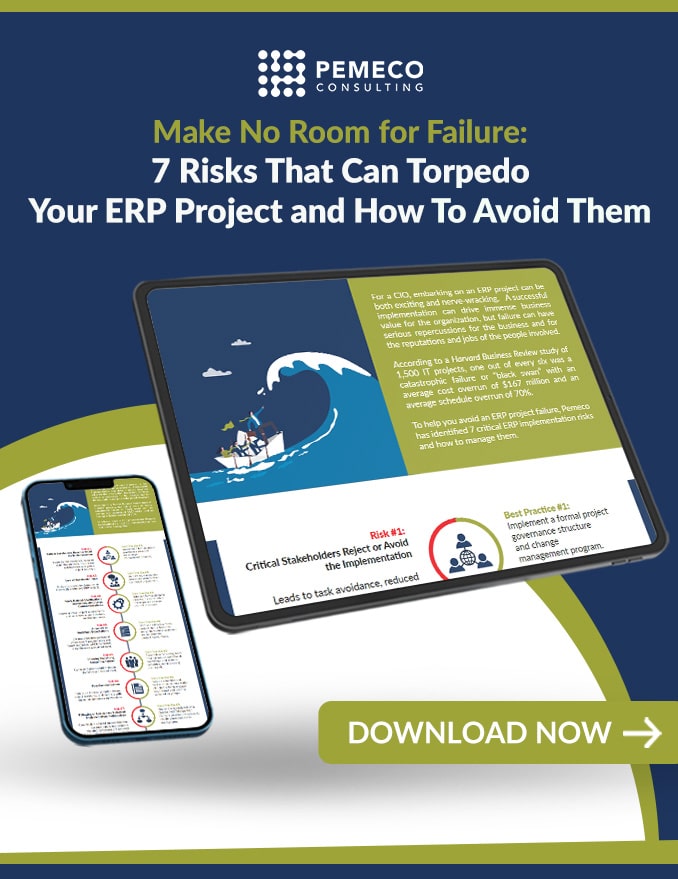Our client, a leading industrial equipment manufacturer, embarked on an ERP implementation project to unify operations under a single platform, Infor LN. The initiative aimed to standardize processes, improve reporting, and optimize resource allocations across its divisions.
However, after deploying Infor LN in a newly acquired division, the client encountered significant user resistance, as employees were accustomed to a heavily customized legacy system. To turn the situation around, the client engaged Pemeco to assess and enhance its business processes, the system’s implementation, and end-user adoption.
Pemeco’s intervention delivered transformative results, resolving critical issues, boosting user satisfaction, and improving operational efficiency. Shortly after our engagement, the client was successfully acquired by one of the world’s largest hardware companies.
The Challenges
Prior to our retainer, our client initiated a company-wide transformation by implementing Infor LN across all its business units. The methodology was based on a global design of best-practice business processes that it would deploy as corporate standard business processes at all divisions.
Midway through the project, our client acquired a multinational electrical distribution and services company. Unfortunately, after our client cut this division over to the new Infor LN system, our client learned that the corporate standard process models failed to support this division’s strategic and competitively differentiating requirements. As a result, the division devised manual processes and Excel-based workarounds to manage daily operations. These workarounds created significant inefficiencies and reporting issues, ultimately compromising company performance.
These challenges not only disrupted operations within the newly acquired division but also posed a risk to the success of the broader ERP initiative.
Our Engagement
Pemeco was engaged to audit the implementation at the newly acquired division and to provide ERP Project Rescue and Recovery services. Following our assessment, it became clear that that the division was in the “Desperation” phase of the Emotional Curve. Transactional processing was inefficient, end-users were becoming increasingly frustrated, and the organization was at significant risk of abandoning the new systems and processes.
Because the company was already live, we did not have the luxury of time. It was critical that we triage the issues and deliver immediate improvements. We identified three key focus areas: optimizing business processes, refining system configurations, and improving user adoption.
We identified 32 gaps and issues categorized by department, focus area (process, system, and change management), complexity (Low, Medium, High), and value.
This methodical approach allowed us to rate gap criticality, impact, and path to value.
The following are samples of the projects:
- Quick Wins:
- Cleaning item unit of measure conversion tables to reduce inventory inaccuracies caused by erroneous calculations.
- To improving planning and scheduling, aligning manufacturing work center calendars with plant operation times.
- Refine training courseware and provide targeted training to the business analysis and end-user communities.
- Medium Complexity:
- Redefine organizational roles to better segregate duties among planning, procurement, and transport scheduling functions.
- Implement warehouse pick logic to prioritize warehouse work relative to delivery date requirements.
- High Complexity:
- Implement license plate handling to enable more efficient material handling processes.
Rapid Recovery and Value Creation
The organization did not have the luxury of time to slowly chip away at the listed projects. Customer orders were being impacted, and the business was increasingly resisting the new processes and system. We prioritized the projects by business needs and complexity and deployed a SWAT Team to rapidly execute the 32 projects. We held multiple status calls weekly, clearly communicating the KPIs on issue resolution and business performance improvements, and removing any roadblocks to progress.
Ultimately, the approach worked.
The division’s performance made a marked recovery within a few short weeks of our SWAT Team’s engagement. End-users significantly increased adoption of the refined processes and leadership gained confidence that the division’s performance was not just stabilizing, but improving.
By the end of the initial engagement, the SWAT Team had resolved a significant percentage of the identified gaps and issues.
Due to the division’s efficiency gains, the client even decided to roll out Pemeco’s recommendations across other divisions.
Driving Continuous Improvement
After the initial project, the client asked Pemeco to assist with project governance, including monitoring ongoing system changes. We also conducted formal training sessions for their IT groups to maximize system utilization. This proactive approach, combined with regular support meetings, ensured sustained positive impact and continuous optimization.
Shortly after our engagement, our client achieved a major milestone – it was acquired at an industry-leading multiple and merged with a global conglomerate, cementing its position as an industry leader.
Optimize your ERP Systems Today
Learn more about Pemeco’s Assessment and ERP Optimization services, or contact our ERP experts.




